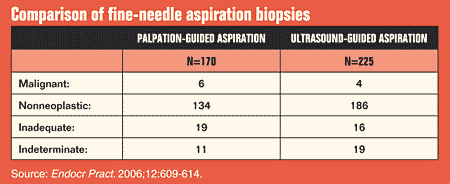Thyroid ultrasonography has many benefits in endocrine practice
Ultrasound-guided fine-needle aspiration biopsy better than palpation for diagnostic accuracy, sensitivity, positive predictive value.
Ultrasound-guided fine-needle aspiration biopsy of thyroid nodules was associated with improved cytologic accuracy, sensitivity and reduced false-negatives compared with palpation-guided aspiration.
The researchers, from the department of medicine at SUNY Upstate Medical University, also found similar malignancy rates between nonpalpable and palpable thyroid nodules.
This research was published in Endocrine Practice.
“The use of ultrasound-guided fine-needle aspiration biopsy of the thyroid and thyroid nodules is very useful in clinical practice,” Roberto Izquierdo, MD, associate professor of medicine and pediatrics and medical director for the Thyroid Cancer Center at SUNY, said in an interview with Endocrine Today.
Management of disease
The role of ultrasonography in the management of thyroid nodular disease is not universal in the endocrine community, according to the researchers. Izquierdo said it is gaining greater acceptance in the outpatient clinic, however.
Palpation-guided aspiration biopsy still has its role in the detection of thyroid nodules, such as when detecting a discrete, easily palpable nodule.
“It may be reasonable to provide the available diagnostic study of thyroid ultrasonography, which is easy to perform and noninvasive, for the evaluation and management of thyroid nodular disease to assist in the early diagnosis and intervention of thyroid malignant lesions,” the researchers wrote.
Izquierdo and colleagues noted a number of benefits of thyroid ultrasonography vs. palpation-guided aspiration biopsy in the outpatient endocrine practice because it:
- Can be done in the physician’s office by the endocrinologist.
- Physicians become more efficient by performing more biopsies.
- Is not time consuming.
- Decreases the false-negative rate.
- Increased diagnostic accuracy.
- Gets better specimens.
- Produces higher sensitivity.
- Improves medical care offered to patients.
- Limits expense and inconvenience.
Comparing the biopsies
The researchers conducted a prospective follow-up study of 276 patients (243 women; mean age, 48.6) who were referred for thyroid nodular disease between October 1997 and August 2001 and who underwent fine-needle aspiration biopsy.
Before 1999, palpation-guided fine-needle aspiration was used; after 1999, ultrasonography was used. Ultrasound-guided aspiration was performed on all solitary palpable and nonpalpable nodules that were at least 1 cm in diameter and in patients with multinodular thyroids. Each examination and biopsy was performed by the same endocrinologist.
The researchers categorized cytologic diagnoses as nonneoplastic, malignant, indeterminate or inadequate and then calculated the diagnostic accuracy, sensitivity, specificity and positive and negative predictive value for each nodule. Malignant or indeterminate cytologic results were classified as a positive case and nonneoplastic cytologic results were classified as a negative case.
There were 395 fine-needle aspiration biopsies performed on 376 thyroid nodules; 170 were palpation-guided on 157 nodules and 225 were ultrasound-guided on 219 nodules. Both types were performed on 21 nodules.

Palpation vs. ultrasonography
Ultrasound-guided aspiration biopsy had fewer inadequate specimens (7.1%) then palpation-guided (11.2%). “With continued improvement in ultrasound performance skills over time, this rate will likely decrease even further,” the researchers wrote.
There was an 80% cytologic diagnostic accuracy rate for ultrasound-guided aspiration biopsy for palpable nodules that were resected vs. 60.9% for palpation-guided aspiration biopsy.
According to the researchers, the cancer yield was higher (52.6% vs. 44%) in the ultrasound group. The malignancy rate for nonpalpable nodules was 5.1% compared with 6.8% for palpable nodules.
Thyroid carcinoma was confirmed in 22 of 44 patients who had previously aspirated thyroid nodules and underwent thyroid resection. Of the 22 carcinomas discovered, 13 (59%) were multifocal and 15 (68%) were found in multinodular thyroid glands.
One concern was the high prevalence of nonpalpable malignant nodules on examination, according to the researchers (six of 22). The malignant nonpalpable nodules had a mean diameter of 2.1 cm vs. 2.7 cm for palpable nodules. There are several reasons why they were not detected, according to the researchers: some were obscured in an enlarged thyroid gland, some were in the back of the thyroid or very low in the neck and were partly substernal.
This points to a decreased sensitivity of the physical examination in the detection of thyroid nodules smaller than 2 cm, Izquierdo and colleagues wrote. “Hence, the routine use of thyroid ultrasonography in the evaluation of suspected thyroid nodular disease and in patients with abnormal findings on thyroid examinations, but not discrete nodules, is recommended to avoid the misdiagnosis of nodules of substantial size (50% of which were larger than 2 cm in the study) that may be cancerous,” they wrote.
Malignant lesions were missed in five of 10 patients who received palpation-guided aspiration compared with just one of 10 patients who received ultrasound-guided aspiration.
“This study has shown that just because the nodule is not palpable doesn’t mean it’s not cancer,” Izquierdo said. “If a nodule is greater than 1 cm, the physician should still aspirate that nodule because it could be malignant at the same rate as a nodule that is palpable. Do not discount a nodule just because it is not palpable.” – by Katie Kalvaitis
For more information:
- Izquierdo R, Aerkat MR, Knudson PE, et al. Comparison of palpation-guided versus ultrasound-guided fine-needle aspiration biopsies of thyroid nodules in an outpatient endocrinology practice. Endocr Pract. 2006;12:609-614.
